Holocene Study guides, Class notes & Summaries
Looking for the best study guides, study notes and summaries about Holocene? On this page you'll find 100 study documents about Holocene.
Page 3 out of 100 results
Sort by
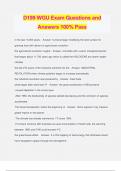
-
D199 WGU Exam Questions and Answers 100% Pass
- Exam (elaborations) • 10 pages • 2024
-
- $12.49
- + learn more
D199 WGU Exam Questions and Answers 100% Pass in the last 10,000 years: - Answer- humans began modifying the land surface for growing food with advent of agricultural revolution the agricultural revolution roughly - Answer- coincides with a warm interglacial period that began about 11,700 years ago which is called the HOLOCENE era (warm stable climate) the last 270 years of the holocene ushered into the - Answer- INDUSTRIAL REVOLUTION when climate pollution began to increase dramatically...
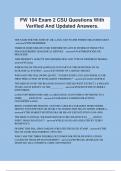
-
FW 104 Exam 2 CSU Questions With Verified And Updated Answers.
- Exam (elaborations) • 6 pages • 2024
-
- $11.49
- + learn more
FW 104 Exam 2 CSU Questions With Verified And Updated Answers. THE NAME FOR THE ZONE OF AIR, LAND, AND WATER WHERE ORGANISMS EXIST. - answerTHE BIOSPHERE. THERE IS SOME DEBATE OVER WHETHER WE LIVE IN EITHER OF THESE TWO ERAS DESCRIBING GEOLOGICAL HISTORY. - answerANTHROPOCENE OR HOLOCENE THIS PROPERTY AFFECTS THE DISTRIBUTION AND TYPE OF DIFFERENT BIOMES. - answerClimate WHICH ONE OF THE FOLLOWING IS NOT PART OF THE DEFINITION OF AN ECOLOGICAL SYSTEM? - answerCONSIST OF A SINGLE SPECIE...
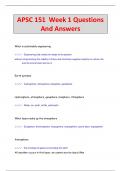
-
APSC 151 Week 1 Questions And Answers
- Exam (elaborations) • 11 pages • 2024
-
- $9.99
- + learn more
KT Event (Cretaceous-tertiary) ~ Massive meteor hits coast of Mexico and causes extinction Massive worldwide cooling Tertiary Period (Cenozoic Era) ~ Climate became cooler and drier, mammals moved from asia to north america via the Bering land bridge, radiation in flowering plants, mammals, lizards, and birds occured. Also, more grasslands appeared Quaternary Period (Cenozoic Era) ~ Huge range of terrestrial mammals, including hominids (us!). As humans evolved and dominated the eart...
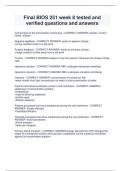
-
Final BIOS 251 week 8 tested and verified questions and answers
- Exam (elaborations) • 8 pages • 2024
- Available in package deal
-
- $12.99
- + learn more
Final BIOS 251 week 8 tested and verified questions and answers Components of the homeostatic control loop - CORRECT ANSWER-receptor, control center, effector Negative feedback - CORRECT ANSWER--works to oppose change -brings condition back to a set point Positive feedback - CORRECT ANSWER--works to enhance change -brings condition further away from a set point Tonicity - CORRECT ANSWER-relates to how the solution influences the shape of body cells Hypotonic solution - CORRECT ANSWE...
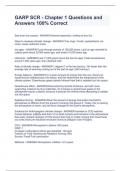
-
GARP SCR - Chapter 1 Questions and Answers 100% Correct
- Exam (elaborations) • 4 pages • 2023
- Available in package deal
-
- $10.49
- + learn more
GARP SCR - Chapter 1 Questions and Answers 100% CorrectGARP SCR - Chapter 1 Questions and Answers 100% CorrectGARP SCR - Chapter 1 Questions and Answers 100% CorrectGARP SCR - Chapter 1 Questions and Answers 100% Correct Sea level rise causes - ANSWER-thermal expansion, melting of land ice Ways to measure climate change - ANSWER-Tree rings, Corals, speleothems, ice cores, ocean sediment cores Ice ages - ANSWER-Cycle through periods of 100,000 years. Last ice age reached its coldest point ...
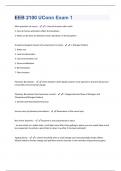
-
EEB 2100 UConn Exam 1 Questions + Answers Graded A+
- Exam (elaborations) • 16 pages • 2024
-
- $7.99
- + learn more
Main questions of course - 1. How do humans alter earth 2. how do human alterations affect the biosphere 3. What can be done to alleviate human alterations of the biosphere Greatest ecological impacts of humans(most to least) - 1. Nitrogen fixation 2. Water use 3. Land transformation 4. CO2 concentration rise 5. Ocean acidification 6. Bird extinction 7. Plant invasion Planetary Boundaries - Limits between which global systems must operate to prevent abrupt and irreversible environment...
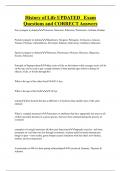
-
History of Life UPDATED Exam Questions and CORRECT Answers
- Exam (elaborations) • 10 pages • 2024
-
- $8.49
- + learn more
Era (youngest to oldest)Cenozoic, Mesozoic, Paleozoic, Proterozoic, Archean, Hadean Period (youngest to oldest)Quaternary, Neogene, Paleogene, Cretaceous, Jurassic, Triassic, Permian, Carboniferous, Devonian, Silurian, Ordovician, Cambrian, Ediacaran Epoch (youngest to oldest)Holocene, Pleistocene, Pliocene, Miocene, Oligocene, Eocene, Paleocene Principle of Superpositionolder rocks will be on the bottom while younger rocks will be on the top, can be used to get a rough estimate of time...
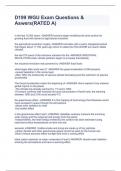
-
D199 WGU Exam Questions & Aswers(RATED A)
- Exam (elaborations) • 6 pages • 2024
-
- $11.49
- + learn more
in the last 10,000 years: -ANSWER humans began modifying the land surface for growing food with advent of agricultural revolution the agricultural revolution roughly -ANSWER coincides with a warm interglacial period that began about 11,700 years ago which is called the HOLOCENE era (warm stable climate) the last 270 years of the holocene ushered into the -ANSWER INDUSTRIAL REVOLUTION when climate pollution began to increase dramatically the industrial revolution was powered by -ANSWER f...
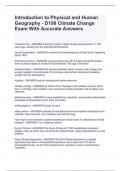
-
Introduction to Physical and Human Geography - D199 Climate Change Exam With Accurate Answers
- Exam (elaborations) • 2 pages • 2024
-
- $10.39
- + learn more
Holocene Era - ANSWER-a period of warm, stable climate starting about 11,700 years ago, allowing for the Agricultural Revolution. Great Acceleration - ANSWER-a period of accelerating use of fossil fuels, beginning about 1950 Anthropocene Era - ANSWER-a period beginning with the Agricultural Revolution when humans began to modify the environment; "the age of humans" Photosynthesis - ANSWER-the process whereby plants convert solar energy into energy needed to live and grow; this process...
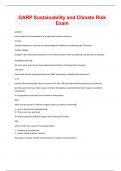
-
GARP Sustainability and Climate Risk Exam
- Exam (elaborations) • 11 pages • 2023
-
- $11.49
- + learn more
GARP Sustainability and Climate Risk Exam weather exact state of the atmosphere at a particular location and time climate long-term patterns or trends of meteorological conditions (usually periods >30 years) climate change change in the statistical properties of the climate system when considered over periods of decades aka global warming for how many years do we have observational history of temperature change? 150 years how much has the earth warmed since 1860, according to sate...

$6.50 for your textbook summary multiplied by 100 fellow students... Do the math: that's a lot of money! Don't be a thief of your own wallet and start uploading yours now. Discover all about earning on Stuvia


